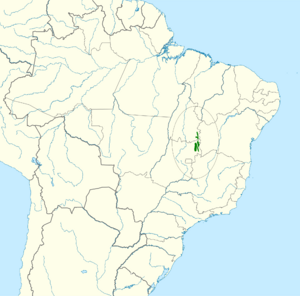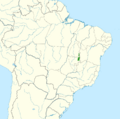Pfrimer's parakeet facts for kids
Quick facts for kids Pfrimer's parakeet |
|
|---|---|
 |
|
| P. pfrimeri in Brazil | |
| Conservation status | |
| Scientific classification | |
| Genus: |
Pyrrhura
|
| Species: |
pfrimeri
|
 |
|
| Synonyms | |
|
Pyrrhura leucotis pfrimeri |
|
The Pfrimer's parakeet (scientific name: Pyrrhura pfrimeri) is a special type of parrot. It doesn't migrate, meaning it stays in the same area all year. You might also hear it called Pfrimer's conure, Goias parakeet, or maroon-faced conure.
This beautiful bird is in danger! Since 2007, groups like the IUCN and BirdLife International have listed it as an endangered species. This means there aren't many left in the wild. Pfrimer's parakeets only live in specific parts of Brazil, mainly in the Goiás and Tocantins regions. They prefer dry forests where trees lose some or all of their leaves, known as Caatinga forests.
Scientists used to think the Pfrimer's parakeet was just a type of white-eared parakeet. But they realized it was different because it lives in a different place, likes different habitats, and looks unique. For example, it has a much smaller pale patch near its ear compared to other similar birds. Recent studies using DNA have confirmed that it is indeed its own species.
Sadly, the number of Pfrimer's parakeets is going down. There are only about 20,000 to 49,000 of them left. The biggest reason for this drop is deforestation, which is when forests are cut down, often for farming. These parakeets usually live for about 6 to 8 years.
Contents
What Pfrimer's Parakeets Look Like
Pfrimer's parakeets are quite colorful! Both young and adult birds have similar feathers.
- Faces and Heads: They have brown and red on their faces and around their ears. Their heads are blue.
- Eyes: Their eyes are brown or orange, surrounded by white or gray rings.
- Beaks: They have gray or black beaks.
- Bodies: Their necks can be green or blue. Their chests are a mix of blue or green with touches of white and brown. Their bellies are reddish-brown.
- Wings and Tails: Their wings show a mix of red, green, and blue. Their tails are usually maroon with a green base.
An adult Pfrimer's parakeet grows to be about 22–23 centimeters (about 8.5–9 inches) long, including its tail.
Where Pfrimer's Parakeets Live
The Pfrimer's parakeet is found only in the Caatinga forests of the Goiás and Tocantins states in Brazil. These birds live in forests where trees lose some or all of their leaves, at heights up to 600 meters (about 2,000 feet).
According to BirdLife International and the IUCN, the area where these birds live is about 20,300 square kilometers (about 7,800 square miles). However, this area is broken up into many smaller pieces. This is because their habitat is being lost and damaged. This is a big reason why BirdLife International has listed this species as Endangered.
How Pfrimer's Parakeets Live
Daily Life and Social Habits
Pfrimer's parakeets are social birds. They usually live in groups, or flocks, of up to 10 birds. When they are flying, these flocks can be quite noisy. But when they are resting or eating high up in the trees, they become very quiet.
Reproduction and Life Cycle
The breeding season for Pfrimer's parakeets is thought to be from April to June. During this time, adult parakeets typically lay about 3 to 8 eggs in their nests.
What Pfrimer's Parakeets Eat
Pfrimer's parakeets mostly eat fruits, berries, and seeds. But they have also been seen eating certain flowers, insects, and even insect larvae (young insects).
Protecting Pfrimer's Parakeets
Why They Are in Danger
As mentioned, the Pfrimer's parakeet is currently an Endangered species. Since they live in such a small area, human activities that affect their habitat are very damaging. There are only about 20,000 to 49,000 of these birds left in Brazil. This number is getting smaller as deforestation (cutting down forests) and habitat degradation (damaging their home) increase.
Human activities like agriculture (farming), mining, and even hunting are causing their population to shrink. The IUCN reports that the natural home of these parakeets has shrunk by 66% in the last 31 years because of deforestation. This deforestation often happens through cutting down specific trees, fires, and changing forest land into pastures for animals.
Conservation Efforts
Currently, the main effort to protect this species is to safeguard some of its natural habitat. Other than this, there are no big conservation plans specifically for the Pfrimer's parakeet.
More research is needed for the Pfrimer's parakeet. Not much is known about this species, so it's hard to find reliable information. While the IUCN has the most data, other groups like the Cornell Lab of Ornithology and BirdLife International don't have complete information. The home of the Pfrimer's parakeet shrinks by 2.1% each year. It urgently needs more protection from logging and agriculture, which are its main threats.
Images for kids




